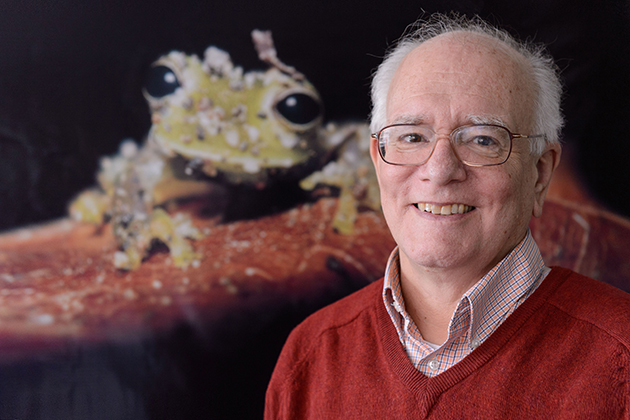
At age 14, Kentwood Wells of Springfield, Va. could rattle off the Latin names of all 100 toads and frogs found in the United States. He had a basement full of cages housing frogs, salamanders, and snakes he’d collected in the woods and streams of his family’s three-acre property. And when he left home to study zoology at Duke University, he left a large, colorful tiger salamander (Ambystoma tigrinum, to be precise) in his mother’s care.
Fifty years later, Wells, professor and head of UConn’s Department of Ecology and Evolutionary Biology, is being honored for his foundational contributions to the fields of animal behavior and ecology.
His scientific paper, titled “The social behaviour of anuran amphibians,” published in 1977, is among the most-read and frequently-cited articles published in the 60-year history of the prestigious journal Animal Behaviour. And this year, it’s the first of 12 papers to be honored with an essay on its impact by the Animal Behavior Society and the Association for the Study of Animal Behaviour, which will commemorate one each month over the course of 2013.
“Wells’s review has played a critical role in the inception of scores of research programs over the past 36 years,” wrote journal editor Mark Bee of the University of Minnesota in his essay, which is titled, “All’s well that begins Wells: celebrating 60 years of Animal Behaviour and 36 years of anuran behavioural ecology.”
The paper, which Wells wrote when he was in graduate school at Cornell, tackled big questions about frog behavior and how these amphibians interact with one another and their surroundings. It summarized what scientists knew – and what they didn’t yet know – about how frogs choose mates, why they’re aggressive toward each other, how they croak, and how they care for their young.
“I feel privileged to have been in on the ground floor of the emerging field of behavioral ecology,” says Wells. “It was an exciting time, and many new ideas were coming out in the field.”
Ecology evolves
Ecologists traditionally focused on particular groups of animals – for example, ornithologists studied birds, herpetologists studied amphibians and reptiles, and entomologists studied insects. But when Wells’s paper came out, scientists were beginning to look more broadly at the way animals behave, asking scientific questions and testing them with experiments.
“Animal behavior was shifting to a hypothesis-driven science,” he says. “The paper was important because it could be applied to other taxonomic groups,” or many other groups of animals.
Susan Herrick, a Ph.D. student of Wells’s, says the paper was written in a clear “Kentwood style” – that is, comprehensive but clear enough to be understood by any reader.
“The paper was written at a time when people were first developing solid ideas and core research questions about the social behavior of many animal groups,” she says. “Anyone who works, even peripherally, in the field of animal behavior would be familiar with this paper.”
Under the direction of his Ph.D. adviser, Harvey Pough, and one of Cornell’s renowned animal behaviorists, Stephen Emlen, Wells studied the mating behavior of green frogs in the Ithaca, N.Y. area. It was there that he wrote his influential paper.
After a postdoctoral fellowship at the Smithsonian Tropical Research Institute in Panama, Wells came to UConn as an assistant professor in 1977, the year his seminal paper was published.
At UConn, Wells embarked on what would become the largest endeavor of his life: a comprehensive book about amphibian ecology.
A life’s work
“Often people will cite my 1977 paper, but they won’t cite my book,” Wells comments.
His book, published in 2007 and titled The Ecology and Behavior of Amphibians (University of Chicago Press), took him 20 years to write, clocks in at 1,148 pages, and weighs more than six pounds. It’s a far cry from the 28-page article that started it all, he says.
“Sometimes I look at that giant book and wonder how in the world I had the energy to do it,” he says. “I am amazed that I wrote it.”
Herrick says Wells’s “encyclopedic knowledge about all things herpetological is legendary and, at first, intimidating. In fact, I was terribly intimidated by him until I sat one-on-one with him to discuss my potential to complete my graduate work with him. It was then that I realized that he is amazingly humble and down-to-earth.”
Wells teaches classes in vertebrate social behavior and herpetology. He says both fields have changed a lot – especially herpetology, which he started teaching 35 years ago. The expansion of knowledge means, he says, that today’s students have it much harder than he did.
“Students today have to be even more successful than I was,” he says. “If you want to do research and be competitive at a place like UConn, you have to start really early. I tell students to read everything in sight.”
But when teaching a class like herpetology, there’s one thing that will never change, and that’s Wells’s favorite part of the class: the field trips.
“The nice thing about teaching herpetology is that in the spring you get to get out at night and go herping,” he says. “We go out with headlamps and boots, and many of the students have never done anything like that, and they love it, looking around in ponds for frogs. Someone almost always ends up coming back soaking wet because they fell in.”



